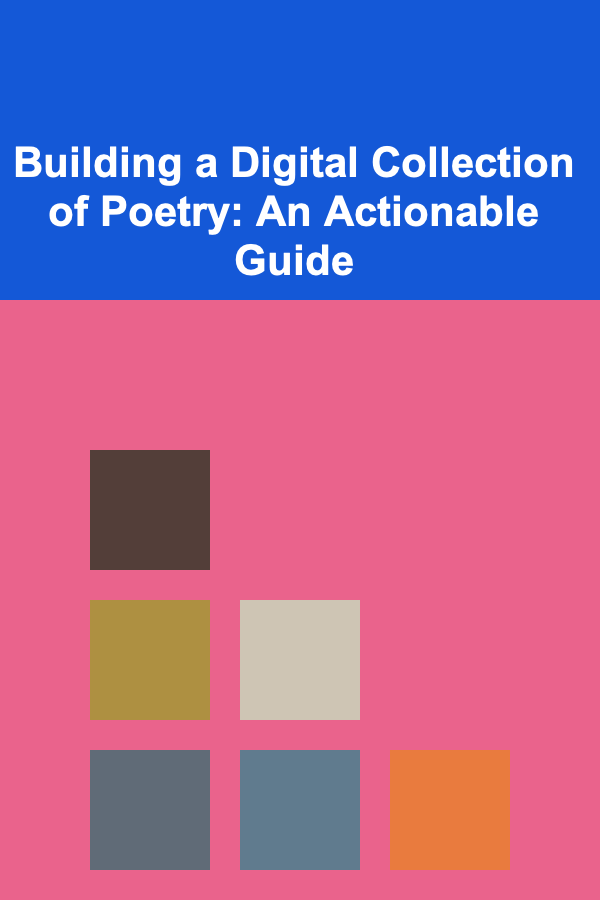
Building a Digital Collection of Poetry: An Actionable Guide
ebook include PDF & Audio bundle (Micro Guide)
$12.99$10.99
Limited Time Offer! Order within the next:

Creating a digital collection of poetry is not only an exciting venture but also a significant opportunity to curate and share art in a medium that is easily accessible, shareable, and, importantly, sustainable. Whether you are an individual poet looking to preserve your own work or a curator gathering poems from multiple poets, the process of building a digital poetry collection involves a mix of creativity, organization, technology, and marketing.
In this guide, we'll walk you through actionable steps for creating your own digital poetry collection, from selecting and organizing your content to ensuring it reaches a wide audience. Whether you're aiming to build a personal anthology or a public project, this guide will help you succeed in your endeavor.
Define Your Collection's Purpose and Audience
Before jumping into the technical aspects of building your digital poetry collection, it's essential to clarify your goals and intended audience. Understanding these key elements will influence everything from the poems you choose to include, the platform you use, and the way you market your collection.
1.1 Decide on the Focus of Your Collection
Your collection could take many different forms, depending on your interests or the purpose behind the project. Consider these common themes:
- Personal Anthology: A collection of your own poems or works inspired by your life, experiences, or artistic evolution.
- Thematic Collection: Poems centered around a specific theme, such as nature, love, political struggle, or identity.
- Multigenre Anthology: A mix of poets and various styles, potentially showcasing contemporary, classical, or diverse poetic traditions.
- Historical/Archival Project: A collection of poems from a particular time, region, or movement, potentially aiming to preserve forgotten works or highlight underrepresented voices.
1.2 Identify Your Audience
Understanding who will read your collection can shape its design and accessibility. Some potential audiences might include:
- Poetry Lovers and Scholars: A more academic approach that includes in-depth annotations, historical context, and literary analysis.
- General Readers: Those who simply enjoy reading poetry but might not be familiar with its deeper theoretical aspects.
- Niche Communities: Readers drawn to specific themes (e.g., LGBTQ+, feminist, postcolonial, experimental poetry).
- Young Adults or Students: You may want to simplify language, provide study guides, or add annotations for readers new to poetry.
Select and Organize Your Content
Now that you have a clear sense of purpose and audience, it's time to begin the process of curating and organizing your content. The way you select and arrange the poems is crucial to the effectiveness of your collection.
2.1 Gather Your Poems
Start by selecting the poems that fit the theme or purpose of your collection. Whether you're collecting your own work or sourcing poems from other writers, ensure that each piece contributes to the overarching theme or purpose. Some methods to gather poetry include:
- Writing Your Own Poems: If you're creating a collection of your own work, begin by reviewing your past poems. Are there common themes, motifs, or styles? Consider including both new and old pieces to show your artistic growth.
- Soliciting Poems: If you are collecting works from other poets, reach out to them and ask for submissions. Make sure you clearly outline your vision for the collection, your target audience, and the rights associated with the poems you plan to use.
- Public Domain Works: If you're looking to include historical or classical poems, search for works that are in the public domain. Many poets, including Shakespeare, Walt Whitman, and Emily Dickinson, have works that can be freely reproduced.
2.2 Organize the Poems
Once you've gathered the poems, it's time to think about how they'll be organized in the digital collection. You'll need a system that makes sense for both your audience and your content. Here are some organization strategies:
- Chronological: Arrange the poems by date of composition or publication. This could work well for an individual poet's work to show development over time.
- Thematic: Group the poems by theme (love, nature, death, etc.). This works well if your collection spans multiple poets or covers a wide range of topics.
- Stylistic Groupings: If the collection spans a wide variety of styles (sonnets, free verse, haiku), consider grouping poems based on form or style.
- Author-Centric: For anthologies with multiple poets, arrange poems by author. This allows readers to explore individual voices and provides clarity when navigating the collection.
2.3 Consider the Digital Medium
Once you have a solid structure for the collection, think about how the digital format will affect its presentation. This could involve designing a specific layout or using multimedia elements to enhance the poetry. Consider:
- Text-Only Format: If your collection is purely textual, think about how the text will be displayed on various devices. You may need to format the text to be mobile-responsive and visually appealing.
- Incorporating Multimedia: If your digital collection is more interactive, you may include multimedia elements, such as audio readings, video performances, or visual artwork that complements the poems. This can help bring the poems to life and engage readers on a deeper level.
Choose the Right Platform
Now that you've organized your content, you'll need to decide where to host your digital collection. There are several options, depending on your needs and the level of interactivity you want to include in your project.
3.1 Self-Hosted Website
If you want full control over the presentation, functionality, and branding of your poetry collection, building a self-hosted website is a great option. WordPress, Wix, and Squarespace all offer easy-to-use website-building tools that are perfect for creating an online poetry collection. A self-hosted site allows you to:
- Customize the design and layout to fit the artistic vision of your collection.
- Include interactive features, such as comment sections or live readings.
- Control the accessibility of your content (free, subscription-based, or one-time purchases).
3.2 E-Book Format (Kindle, EPUB, PDF)
If you want your digital collection to be more like a traditional book, you can create an e-book version. This could be a standalone collection or a downloadable version of your anthology. Use tools like Calibre or Adobe InDesign to format your content into professional e-book formats. This format allows for easy distribution on platforms like Amazon Kindle , Apple Books , or Smashwords.
3.3 Poetry Sharing Platforms
There are several online platforms dedicated to poetry that could host your collection, such as Poetry Foundation , Medium , or Issuu. These platforms often have large, engaged audiences and can help you promote your work to the right readers.
3.4 Social Media and Blogging
If you're looking for more informal or real-time engagement, you can use social media platforms or blogs to share your collection. For example, you can post excerpts of poems on Instagram , Tumblr , or Twitter, linking back to your full collection or website.
Design an Engaging User Experience
The digital nature of your poetry collection means you need to think carefully about how users will interact with your content. Creating a seamless and engaging experience for your readers will increase their enjoyment and keep them coming back for more.
4.1 Intuitive Navigation
Ensure that readers can easily browse through your collection, whether it's by theme, poet, or form. Use clear menus, search functions, and navigation buttons so readers can easily find what they're looking for.
4.2 Visual Design
If you're presenting your collection on a website or blog, make sure the design is visually appealing and easy to read. Choose a clean font and a color scheme that reflects the mood of your poetry. A simple, minimalist design often works best for poetry, allowing the words to be the focal point.
4.3 Mobile-Friendly Format
More people than ever are reading digital content on their mobile devices. Ensure that your collection is mobile-friendly by using responsive design techniques. This way, your readers can enjoy your poetry on any device---whether it's a phone, tablet, or desktop.
Market and Share Your Collection
Once your digital poetry collection is ready to be shared with the world, you'll need to market it effectively. Here are some strategies to help promote your work:
5.1 Leverage Social Media
Social media is an excellent way to reach potential readers. Share snippets of your collection, host live readings, and engage with poetry communities. Platforms like Instagram , Twitter , and TikTok are especially popular for poetry, where people share both written content and multimedia performances.
5.2 Email Newsletter
Create an email list to keep your readers updated on new poems, events, or updates about your collection. Offering free excerpts or exclusive content in your newsletter can incentivize more sign-ups.
5.3 Collaborate with Other Poets or Creators
Collaborating with other poets, artists, or influencers can give your collection wider exposure. Consider guest features, interviews, or joint projects that allow you to tap into their audience while also showcasing their work.
5.4 Submit Your Work to Online Literary Magazines
Many online literary magazines or poetry journals accept submissions from poets and curators. Submit excerpts or entire sections of your collection for wider visibility and credibility.
Maintain and Update Your Collection
A digital poetry collection should be dynamic, evolving as your artistic journey progresses. Continue to update your collection with new works, collaborate with fresh voices, and keep your audience engaged by offering them new content regularly.
6.1 Add New Poems
If your collection is ongoing, make sure to regularly add new poems that fit the theme or purpose of the collection. This keeps the content fresh and encourages repeat visits.
6.2 Respond to Feedback
Engage with your readers and incorporate their feedback where appropriate. Whether it's through comments, social media interactions, or surveys, understanding how people are connecting with your work can help you refine your collection and make it even more meaningful.
Conclusion
Building a digital collection of poetry is an exciting and fulfilling project that allows you to share the art of poetry with a broader audience. By selecting compelling content, choosing the right platform, designing an engaging experience, and promoting your work effectively, you can create a collection that resonates with readers and stands the test of time. With technology at your fingertips, the possibilities for how you present and share poetry are endless---embrace the process and let your creativity shine.
Reading More From Our Other Websites
- [Personal Care Tips 101] How to Choose Antiperspirant for Hot Weather or Tropical Climates
- [Personal Care Tips 101] How to Lose Weight Without Feeling Deprived
- [Home Storage Solution 101] How to Declutter and Organize Your Medicine Cabinet for a Stress-Free Morning Routine
- [Home Security 101] How to Secure Your Home's Doors and Windows Effectively
- [Personal Care Tips 101] How to Find the Best Lipstick for a Professional Look
- [Weaving Tip 101] Mastering Advanced Weaving Techniques: A Guide for the Modern Adult Hobbyist
- [Home Space Saving 101] How to Optimize Storage with a Bookcase with Storage
- [Organization Tip 101] How to Measure and Cut Stair Treads for a Perfect Fit
- [Home Security 101] How to Use Frontpoint Security to Enhance Your Home Protection
- [Home Lighting 101] How to Light Your Entryway for Maximum Impact and Functionality

How to Choose Budget-Friendly Paint Colors to Transform Your Space
Read More
How to Score the Best Deals with Consignment Shopping
Read More
How to Select Energy-Efficient Bulbs for Your Home
Read More
How to Use the Envelope System for Cash Budgeting
Read More
Getting Started with Your First VR Headset: A Deep Dive
Read More
How to Make Printable Gift Tags for a Variety of Styles
Read MoreOther Products

How to Choose Budget-Friendly Paint Colors to Transform Your Space
Read More
How to Score the Best Deals with Consignment Shopping
Read More
How to Select Energy-Efficient Bulbs for Your Home
Read More
How to Use the Envelope System for Cash Budgeting
Read More
Getting Started with Your First VR Headset: A Deep Dive
Read More